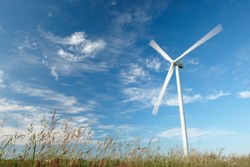Carbon Fiber 2013 report, part 3: Wind energy
Wind and carbon fiber were, at one time, inexorably linked. But that may not be the case — at least for now.

The wind industry has long been forecast as major consumer of carbon fiber, particularly in wind blade spar caps. Even projections offered at the Carbon Fiber 2013 conference (Dec. 9-12, 2013, Knoxville, Tenn., USA) reported aerospace and wind as the two largest markets for the material now and for several years to come. However, two presentations at the conference cast carbon fiber's future in wind in doubt. Steve Johnson, manufacturing engineering manager at GE Wind Energy, was overall positive about wind's future in North America — wind, at $0.06/kWhr is competitive with natural gas — but noted that remaining competitive requires that manufacturing costs be kept in check. "Cost is king in the wind industry," he said. In addition, although low blade weight is important, it's not critical, thus carbon fiber is not considered, by GE, to be an essential manufacturing material, particularly given carbon fiber's relatively high cost. A carbon fiber spar cap, Johnson said, weighs 80 percent less than a glass fiber spar cap, but costs five times more. "We love carbon fiber, but we hate the cost associated with it," he concluded.
Johnson was followed by Aaron Barr, technical advisor at MAKE Consulting (Chicago, Ill., USA), who also addressed carbon fiber use in wind blades. Like Johnson, Barr is optimistic about global wind energy production — 2013 will be a "down" year, followed by several years of anticipated expansion. Barr noted that only two blade manufacturers, Vestas and Gamesa, are using carbon fiber in spar caps, with Vestas accounting for a vast majority of that total. Vestas, however, is struggling financially and faces an uncertain future. Barr noted that carbon fiber's penetration as a percentage of installed wind blades is expected to drop from a high of 23 percent in 2012 to 19 percent in 2013 to 18 percent by 2016. "There's no magic number for when you need carbon fiber," he said, and projects "flat" carbon fiber use in wind blades through 2020. "All of this, however," he said, "is underpinned by just a few OEMs using carbon fiber." The tipping point for carbon fiber might come in the form of a cheaper precursor, which would be expected to reduce the cost of carbon fiber to $5/lb, which MAKE anticipates will occur by 2018.
What does the future hold for carbon fiber in wind blades? With only one turbine manufacturer, Vestas, consuming most of the carbon fiber used in wind blades, the prospects are perhaps not so bright. It's clear, however, based on Johnson's presentation, that carbon fiber's appeal is inversely proportional to its price. Development of non-PAN precursors and subsequent carbon fiber price reductions could bring carbon fiber back into the wind. Stay tuned.
Related Content
-
Composites end markets: Energy (2024)
Composites are used widely in oil/gas, wind and other renewable energy applications. Despite market challenges, growth potential and innovation for composites continue.
-
Recycling end-of-life composite parts: New methods, markets
From infrastructure solutions to consumer products, Polish recycler Anmet and Netherlands-based researchers are developing new methods for repurposing wind turbine blades and other composite parts.
-
RTM, dry braided fabric enable faster, cost-effective manufacture for hydrokinetic turbine components
Switching from prepreg to RTM led to significant time and cost savings for the manufacture of fiberglass struts and complex carbon fiber composite foils that power ORPC’s RivGen systems.







.jpg;maxWidth=300;quality=90)



